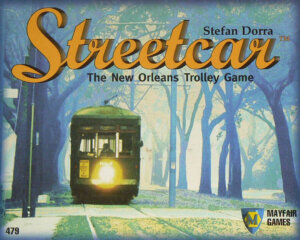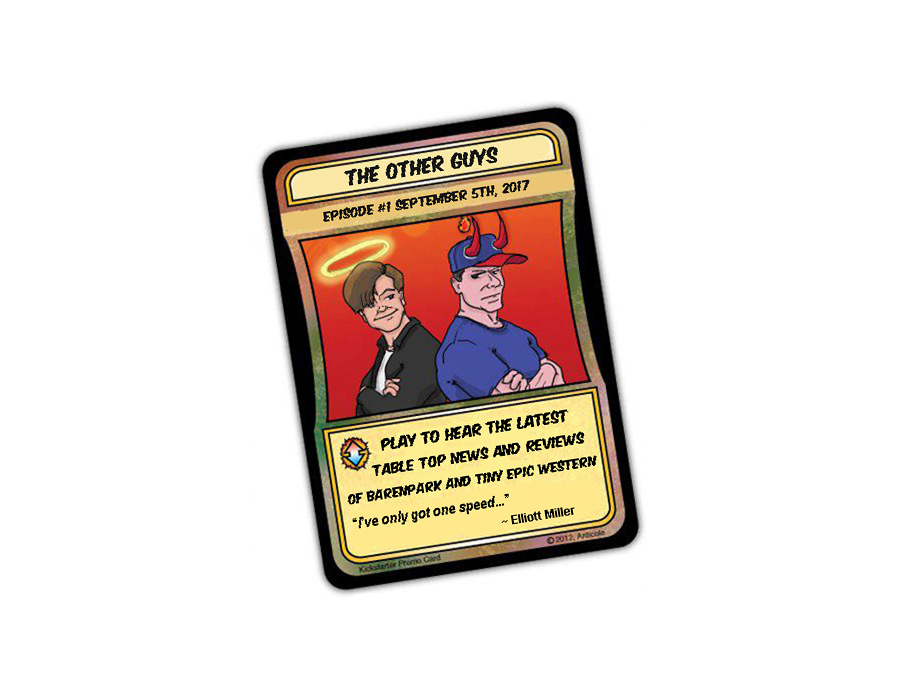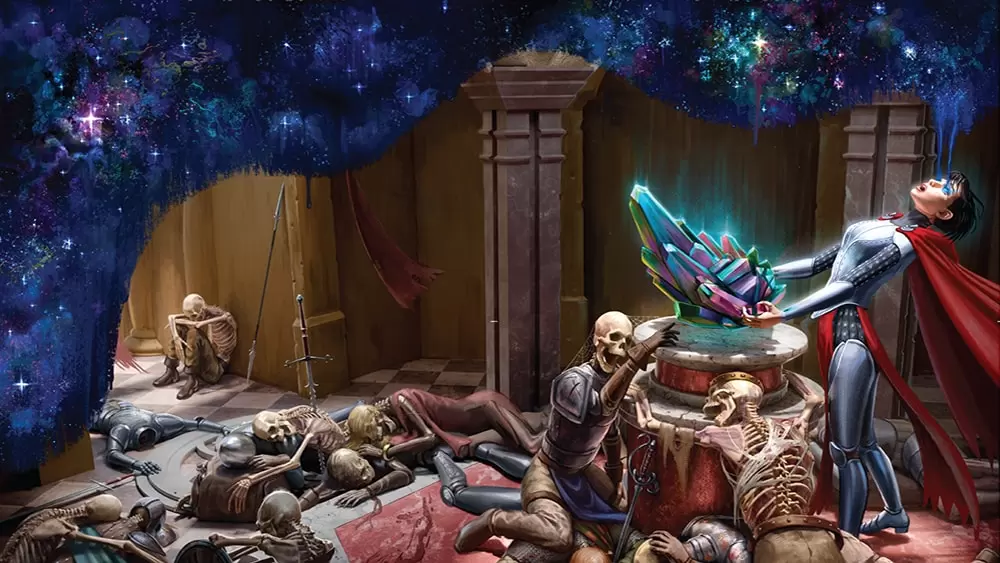Publisher: Mayfair Games
Designer: Stefan Dorra
Artists: Chris Vande Voort, Franz Vohwinkel
Year: 1995
Players: Two to six players
Ages: 10+
Playing time: 60 minutes
Genre: Light strategy game of line placement and streetcar racing
MSRP: $30.00
Streetcar is a fun game which should easily appeal to gamers who are new to the hobby as well as being a pleasant pastime for veteran gamers too. As far as a game that’s going to hit the table on a regular basis though? I would say the limitations on strategy and the rather anticlimactic “race” to end the game take something away from the overall enjoyment making this a title that is best broken out on occasion as a nice wind up of wind down to a day or night of gaming, or as an introduction to the hobby for your non-gaming friends.
Originally published as Linie 1 by Goldseiber, Streetcar is certainly easy to learn. The object of the game is for two to six players to connect end points of their street car line, by the laying of track tiles, while making two or three stops along the way. The player’s path is determined by two randomly dealt cards displaying the color and number of the end points and the stops for that color. Players do not have to reveal what their end points, or required stops, are to any of the other players.
Once the secret paths are determined, each player is dealt five track tiles to be laid on the simple square board to build their street car line. Each turn players may lay two track tiles. Each tile is a rail connection which can be a straight line, an intersection, a junction, or even a loop. Once these track sections are placed on the board they can be removed by any player as long as A) the existing tile has no green bushes located on it – about one third of the tiles have bushes, and b) the replacement tile preserves the existing track connections. For example a straight line of track could be replaced with an intersection.
The various stops represent tourist attractions around the city of New Orleans and a stop sign is placed at each attraction. These stop signs will bring all street car traffic to end their turn during the racing portion of the game. Overall the game is very abstract and the inclusion of the New Orleans setting doesn’t bring much to the experience.
There is a bit of “take that” involved with Steetcar because you’ll be focused on derailing your opponents while looking to advance your cause at the same time. Since tiles can be replaced, under many circumstances, players will try to guess what points their opponents need to connect and do everything they can to either disrupt those lines or make them longer or more time consuming to travel.
Everyone reveals their secret end points and stops once they believe they’ve completed a line that connects them all. The line is then verified to make sure the player has met their goals. This is important because it isn’t unusual for a player to think that they have completed a line only to find that a curve or turn they thought existed, in reality, does not; a savvy player isn’t going to physically trace their route by finger – that would reveal their secret path to the other players! This aspect of the game means that you might want to get a session of Streetcar in before the adult beverages start flowing…
If the player’s path has been completed, then street car race is on!
The player places his streetcar at one end point on the track and attempts to race it to the other end point. A speedometer printed on the board dictates the maximum number of spaces a streetcar may move in a turn. Players are able to increase their speed by one each turn but certain tiles cause slowdowns and the aforementioned stops bring the streetcar movement for the turn to an end.
Obviously, the first player to travel from one end point to the other is the winner.
So why is Streetcar a good game and not a great game? There are a few reasons actually. First, I have to mention the components. Most Mayfair titles have really nice, quality components. That isn’t the case with Streetcar: the tiles are awfully thin – barely thicker than cardboard – and probably won’t hold up to very many replays. Also the streetcar tokens have stickers to be placed on them and those stickers are pretty shabbily made and ill-fitting. All in all, the contents just feel cheap.
Second, the random nature of the tiles takes away part of the aspect of putting together a solid strategy. I know many people will think that having five tiles to choose from at any given time would give a player a lot of options but that isn’t the case; having five loops in hand when you need a straight line does not make for interesting play. One solution for this would be to increase the number of tiles each player has to choose from to possibly six or even seven.
Lastly, the race portion of the game is kind of a letdown. Laying tiles to complete your streetcar line while doing what you can to prevent other players from completing theirs can be a lot of fun. Once the race begins (and, more times than not players complete their lines practically on the same turn) all that takes place is seeing who put together the most effective path. The various aspects of stops and speed restrictions, based on the type of tile might sound like they add something to the race but the reality is they don’t. Most players might be better served by skipping the race entirely and simply counting up the number of tiles making up the route to determine the winner. Of course the race portion could be worse; in the Linie 1 version players rolled a die to determine how far their streetcar would move. That certainly had to be a huge buzzkill.
In the end, Streetcar is a good time (especially during the track laying portion) and isn’t a bad game by any stretch. It just feels as if there is the making of a great game marred by the anticlimax of the remaining race portion. Pick up Streetcar if you’d like to have a nice game to wind up or down a gaming session for the “beer and pretzels” crowd or for those who enjoy a light strategy game.
[rwp-review id=”0″]
- The Terror Beneath Horror RPG is Out in Print and PDF - Nov 22, 2024
- Ashes Without Number Roleplaying Game is Up on Kickstarter - Nov 22, 2024
- Dragonmeet to See the Return of RuneQuest: Sun Country from Chaosium Inc - Nov 22, 2024

















